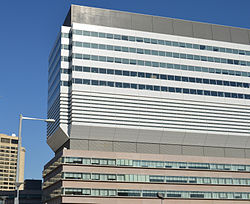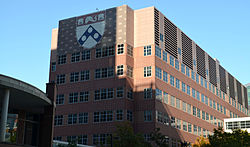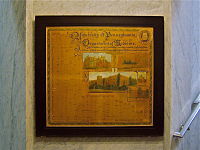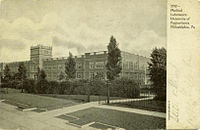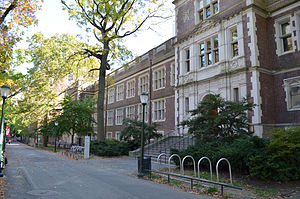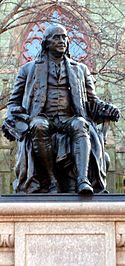- Perelman School of Medicine at the University of Pennsylvania
-
Perelman School of Medicine at the University of Pennsylvania 
Established 1765 Type Private Dean Dr. J. Larry Jameson Academic staff 1,700 full time Students 725 (MD students)
570 (PhD students)
160 (MD/PhD students)Location Philadelphia, Pennsylvania Campus Urban Former names University of Pennsylvania School of Medicine also known as Penn Med Affiliations University of Pennsylvania Website http://www.med.upenn.edu/ The Perelman School of Medicine (also known as Penn Med), formerly the University of Pennsylvania School of Medicine, was founded in 1765, making it the oldest American medical school. As part of the University of Pennsylvania, it is located in the University City section of Philadelphia, Pennsylvania. It is widely regarded as one of the world's top medical schools. In 2011, Penn Med was ranked second overall after Harvard Medical School among research-based medical schools by U.S. News & World Report.[1]
Contents
History
The school's young founder, John Morgan, was among the school's Edinburgh, Scotland and London, England educated faculty. In 1765, after spending five years training in London and Edinburgh, Dr. Morgan returned to Philadelphia and persuaded the Trustees of the University of Pennsylvania to found the first medical school in America. Shortly thereafter, he delivered an address, "Upon the Insitution of Medical Schools in America" during which he expressed his desire for the new medical school to become a model institution:[2]
Perhaps this medical institution, the first of its kind in America, though small in its beginning, may receive a constant increase of strength, and annually exert new vigor. It may collect a number of young persons of more ordinary abilities, and so improve their knowledge as to spread its reputation to different parts. By sending these abroad duly qualified, or by exciting an emulation amongst men of parts and literature, it may give birth to other useful institutions of a similar nature, or occasional rise, by its example to numerous societies of different kinds, calculated to spread the light of knowledge through the whole American continent, wherever inhabited.That autumn, students enrolled for "anatomical lectures" and a course on "the theory and practice of physick." Modeling the School after the University of Edinburgh, the need for supplemental medical lectures with bedside teaching was emphasized, which was satisfied by practitioners at the Pennsylvania Hospital.[3]
The School of Medicine's faculty was nationally renowned: Benjamin Rush (medicine), Philip Syng Physick (surgery), Robert Hare (chemistry), and, around the 1850s, William Pepper (medicine) and Joseph Leidy (anatomy). In 1847, the group of physicians who organized the American Medical Association effectively gave recognition to the School's fame by naming the AMA's first president Nathaniel Chapman, Professor of Medicine at the School.[4]
Name
On May 10, 2011 university president Amy Gutmann announced that the University of Pennsylvania School of Medicine will be officially renamed the Raymond and Ruth Perelman School of Medicine at the University of Pennsylvania in honor of a $225 million contribution made to the medical school by Raymond G. Perelman, 93, a Philadelphia based philanthropist and father of billionaire Ronald Perelman. This sets the record as the largest donation given in U.S. history to rename a medical school. Together with a $25 million contribution made in 2005 to create the Ruth and Raymond Perelman Center for Advanced Medicine, the Perelman family contribution to the medical school to date is approximately $250 million.[5][6] Note that the short version of the name, Perelman School of Medicine, is also an official name of the school.[7]
Campus
In the 1870s, the university closed its campus in Center City, Philadelphia and established a new location across the Schuylkill River in West Philadelphia, just north of the Blockley Almshouse. As part of this move, the School of Medicine's faculty persuaded the University's trustees to build a teaching hospital on the new campus, the Hospital of the University of Pennsylvania (HUP).[8] Today, its affiliated hospitals include the Hospital of the University of Pennsylvania (first teaching hospital in America), Pennsylvania Hospital (first hospital in America), and Penn Presbyterian Medical Center which comprise the University of Pennsylvania Health System.
The administrative offices of the School of Medicine are primarily located within Stemmler Hall and the John Morgan Building. Most educational and research buildings of the school are located on the main campus of the University of Pennsylvania within a triangle made up of Hamilton Walk, University Avenue, and Civic Center Blvd.
The Penn School of Nursing building and the Philadelphia Medical Examiner's Office are both located within the School of Medicine complex.
Buildings
Listed below are the current buildings of the Perelman School of Medicine, not including those of any of the affiliated hospitals.[9] [10] [11]
Building Name Year Built Architect(s) Area (sq. ft.) Anatomy Chemistry Building 1928 Stewardson & Page 128114 Biomedical Research Building 2/3 1999 Perkins & Will, Francis Cauffman, Foley Hoffman 385000 Blockley Hall 1964 Supowitz & Demchick 166425 Claire M. Fagin Hall (Nursing) 1972 Fisher Associates 165600 Clinical Research Building 1989 Payette Associates, Venturi, Ranch, and Scott Brown 204211 Cyclotron 1987 Francis, Cauffman, Wilkinson, Pepper 8122 Edward J. Stemmler Hall
formerly the Medical Education Building, until 1990 [12]1978 Geddes, Brecher, Qualls, and Cunningham 251344 John Morgan Building
formerly the Medical Laboratories, until 1987 [9]1904 Cope & Stewardson 211140 Richards Medical Research Laboratories 1962 Louis Kahn 107103 Robert Wood Johnson Pavilion 1969 Alexander Ewing, Erdman & Eubank 161228 Stellar-Chance Laboratories
formerly the Biomedical Research Laboratories, until 1995 [13]1994 Bower Lewis Thrower 213620 Translational Research Center 2010 Rafael Viñoly Architects PC 500000 Translational Research Laboratory (and addition) 1948
2004Tsoi/Kobus & Associates 129418 Medical advancements
During the late nineteenth and early twentieth centuries, the School of Medicine was one of the earliest to encourage the development of the emerging medical specialties: neurosurgery, ophthalmology, dermatology, and radiology. Between 1910 and 1939, the chairman of the Department of Pharmacology, Alfred Newton Richards, played a significant role in developing the University as an authority of medical science, helping the United States to catch up with European medicine and begin to make significant advances in biomedical science.
In the 1950s and early 1960s, Dr. Jonathon E. Rhoads of the Department of Surgery (which he would later go on to head for many years), mentored Dr. Stanley Dudrick who pioneered the successful use of total parenteral nutrition (TPN) for patients unable to tolerate nutrition through their GI tract.[14]
In the 1980s and 1990s, Dr. C. William Schwab, a trauma surgeon, led numerous advances in the concept of damage control surgery for severely injured trauma patients.[15]
In the 1990s and 2000s, Dr. Paul Offit, a professor of Pediatrics at the School of Medicine and Children's Hospital of Philadelphia, lead the scientific advances behind the modern RotaTeq vaccine for infectious childhood diarrhea.
In 2006, Drs. Kaplan and Shore of the Department of Orthopedics discovered the causative mutation in fibrodysplasia ossificans progressiva, an extremely rare disease of bone.[16]
Medical curriculum
Benchmark changes in the understanding of medical science and the practice of medicine have necessitated that the school change its methods of teaching, as well as its curriculum. Large changes were made in 1968, 1970, 1981, 1987, and 1997. The last significant change in 1997 brought about the institution of Curriculum 2000, "an integrated, multidisciplinary curriculum which emphasizes small group instruction, self directed learning and flexibility." Three themes, Science of Medicine, Art and Practice of Medicine, and Professionalism and Humanism, were developed by focus groups consisting of department chairpersons, course directors, and students.[17]

The Doctor of Medicine (MD) curriculum is broken into six modules, each of which has its own courses:[18]
- Core Principles
- Integrative Systems and Disease
- Technology and Practice of Medicine
- Required Clinical Clerkships
- Electives, Selectives, and Scholarly Pursuit
- Professionalism and Humanism
The MD program is a four year program that can be described in relation to traditional semesters, with the modules for that semester and the courses taken for each. The first three semesters use about half the time for lectures and the other half for small group learning and problem-based learning.[19]
- Semester 1
- Module 1: basic sciences, basic medical sciences, and gross anatomy
- Module 3: doctor-patient relationship, communication skills, and a longitudinal patient experience
- Module 6: cultural competencies
- Semesters 2, 3
- Module 2: organ systems-based courses
- Module 3: clinical decision making, health care systems, introduction to clinical medicine, longitudinal patient experience, differential diagnosis, and medical simulations
- Module 6: research ethics, doctoring, and communication
- Semesters 4, 5
- Module 4: required clinical clerkships
- Module 6: doctoring, communication, and patient safety
- Semesters 6, 7, 8
- Module 5: electives, selectives, "frontiers in medicine," (during which updates to medical science are discussed) and the required scholarly pursuit
- Module 6: communication, and bioethics
In addition to the MD curriculum, the school offers certificate programs in global health, women's health, community health, clinical neuroscience, and aging. There is also a combined degree option with the MD degree in combination with Doctor of Philosophy (Ph.D.), Juris Doctor (JD), Master of Business Administration (MBA), Master of Bioethics (MBE), Master of Science in Clinical Epidemiology (MSCE), Master of Science in Translational Research (MTR), Master of Public Health (MPH), and Master of Science in Health Policy Research (MSHP).[20] There also exists the option for an extra year to pursue various avenues, including research or finishing the requirements for a second degree.[21]
Biomedical Graduate Studies
Biomedical Graduate Studies, contained within the Perelman School of Medicine, was established in 1985 and serves as the academic home within the University of Pennsylvania for roughly 700 students pursuing a PhD in the basic biomedical sciences. BGS consists of more than 600 faculty members across seven Penn schools and several associated institutes including Wistar Institute, Fox Chase Cancer Center, and Children's Hospital of Philadelphia.[22] There are seven graduate programs, labeled by the school as "graduate groups," that lead to a Ph.D. in basic biomedical sciences.[23]
- Biochemistry and Molecular Biophysics
- Cell and Molecular Biology with programs in
- Cancer Biology
- Cell Biology and Physiology
- Developmental, Stem Cell, and Regenerative Biology
- Gene Therapy and Vaccines
- Genetics and Gene Regulation
- Microbiology, Virology, and Parasitology
- Epidemiology and Biostatistics
- Genomics and Computational Biology
- Immunology
- Neuroscience
- Pharmacology
All students receive a stipend in addition to a full fellowship and tend to receive the degree within a median time frame of 5.4 years.[24] There is also the option for students to pursue an additional certificate in medicine, public health, and environmental health sciences.[25] Each graduate group has its own admission policy and training mission, and hence curriculum greatly varies.[22]
Governance
"Penn Medicine" is the governing board that administers and coordinates the Perelman School of Medicine and the University of Pennsylvania Health System (UPHS). The board reports directly to the trustees of the University of Pennsylvania. It was created by Penn's former president, Judith Rodin, in response to a $300 Million financial crisis at the Health System.[26]
Departments
The School of Medicine has departments in the following basic science subjects: Biochemistry and Biophysics, Biostatistics and Epidemiology, Cancer Biology, Cell and Developmental Biology, Genetics, Medical Ethics and Health Policy, Microbiology, Neuroscience, Pharmacology, and Physiology. The school also has departments in the following clinical practices: Anesthesiology and Critical Care, Dermatology, Emergency Medicine, Family Practice and Community Medicine, Medicine, Neurology, Neurosurgery, Obstetrics and Gynecology, Ophthalmology (See Scheie Eye Institute), Orthopaedic Surgery, Otorhinolaryngology, Pathology and Laboratory Medicine, Pediatrics (See Children's Hospital of Philadelphia), Physical Medicine and Rehabilitation, Psychiatry, Radiation Oncology, Radiology, and Surgery.[27]
Centers and institutes
Main article: List of Centers and Institutes at the Perelman School of MedicineThe Perelman School of Medicine, in conjunction with the University of Pennsylvania Health System, has contained within it many centers and institutes dealing with clinical medicine, clinical research, basic science research, and translational research.[28]
Notable alumni
- Caspar Wistar, Class of 1782: president of the American Philosophical Society and President of the Society for the Abolition of Slavery
- Nathaniel Chapman, Class of 1800: first President of the American Medical Association
- Reuben D. Mussey, Class of 1809: in 1862, wrote a history of tobacco documenting its dangers
- Clement Finley, Class of 1818: 10th Surgeon General of the United States Army
- George McClellan, Class of 1819: founder of Jefferson Medical College
- John Light Atlee, Class of 1820: one of the organizers of, and past President of the American Medical Association
- Joseph Pancoast, Class of 1828: surgeon and department chairman at Jefferson Medical College; author of A Treatise on Operative Surgery
- Thomas R. Potts, Class of 1831: first mayor of St. Paul, Minnesota[29]
- David Hayes Agnew, Class of 1838: surgeon and author of The Principles and Practice of Surgery
- William Carlos Williams, Class of 1906: poet, pediatrician, and general practicioner
- Isaac Starr, Class of 1920: developed the first practical ballistocardiograph; 1957 Albert Lasker Award, 1967 Kober Medal of the Association of American Physicians, 1977 Burger Medal of the Free University of Amsterdam[30]
- William Holmes Crosby, Class of 1940: one of the founding fathers of modern hematology
- Gerald Edelman, Class of 1954: 1972 Nobel Prize in Physiology or Medicine; founder and director of The Neurosciences Institute
- David E. Kuhl, Class of 1955: 2009 Japan Prize, best known for his pioneering work in positron emission tomography
- Michael Stuart Brown, Class of 1966: 1985 Nobel Prize in Physiology or Medicine
- Stanley Prusiner, Class of 1968: 1997 Nobel Prize in Physiology or Medicine
- Mehmet Oz, Class of 1986: cardiothoracic surgeon and host of The Dr. Oz Show
Rankings
United States Medical School Ranking Systems
Organization Rank Year U.S. News, Research[1] 2 2011 National Institutes of Health[31], by funding 3 2010 U.S. News, Primary Care[1] 9 2011 International Clinical Medicine, Pre-Clinical Medicine, and Pharmacy Ranking Systems
Organization Country Rank Year Times Higher Education[32] United Kingdom 16 2010 QS World University Rankings[33] United Kingdom 21 2011 Academic Ranking of World Universities[34] China 22 2011 See also
- Medical schools in Pennsylvania
- List of Ivy League medical schools
- University of Pennsylvania Health System
References
- ^ a b c "University of Pennsylvania | Best Medical School". U.S. News. http://grad-schools.usnews.rankingsandreviews.com/best-graduate-schools/top-medical-schools/university-of-pennsylvania-04100. Retrieved 14 October 2011.
- ^ Thorpe, Francis M. (July 1985). "The University of Pennsylvania" (Magazine). Harper's Magazine: pp. 289. http://www.archives.upenn.edu/primdocs/harpers1895/harpers1895.html. Retrieved 19 October 2011.
- ^ Nitzsche, George Erazmus (1918). University of Pennsylvania: its history, traditions, buildings and memorials. Philadelphia, PA: International Printing Company. pp. 13. http://books.google.com/books?id=CWYgAAAAMAAJ&pg=PA13.
- ^ Frances Gurney Smith and John B. Biddle, ed (1853). The Medical examiner, and record of medical science, Volume 9. Philadelphia, PA: Lindsay & Blakiston. pp. 532-5. http://books.google.com/books?id=khYCAAAAYAAJ&pg=PA532&hl=en#v=onepage&q&f=false. Retrieved 19 October 2011.
- ^ New York Times: Perelmans Rename Penn Med
- ^ Raymond and Ruth Perelman Donate $225 Million to the University of Pennsylvania’s School of Medicine
- ^ "Perelman School Renaming Information". http://www.med.upenn.edu/perelmanrenaming/. Retrieved 2 October 2011.
- ^ "School of Medicine, A Brief History". University of Pennsylvania. http://www.archives.upenn.edu/histy/features/schools/med.html. Retrieved 29 October 2011.
- ^ a b Cooper, David Y., III; Marshall A. Ledger (1990). Innovation and Tradition at the University of Pennsylvania School of Medicine. Philadelphia, PA: University of Pennsylvania Press. pp. 323-4. ISBN 978-0812282429.
- ^ "Timeline of University History". University History. University of Pennsylvania. http://www.archives.upenn.edu/histy/genlhistory/timeline.html. Retrieved 12 October 2011.
- ^ "Campus Map". University of Pennsylvania. http://www.facilities.upenn.edu/map.php. Retrieved 12 October 2011.
- ^ Spiegel, Peter. "Planned campus center gets Revlon name". The Daily Pennsylvanian. University of Pennsylvania. http://thedp.com/index.php/article/1990/10/planned_campus_center_gets_revlon_name. Retrieved 12 October 2011.
- ^ Sies, Helmut. "In memoriam Prof. Dr. Britton Chance". http://medfak.uniklinikum-duesseldorf.de/deutsch/MedizinischeFakultt/Aktuelles/Archiv/InmemoriamProfDrBrittonChance/print.html. Retrieved 12 October 2011.
- ^ http://www.upenn.edu/almanac/v48/n17/Rhoads.html
- ^ http://www.uphs.upenn.edu/surgery/faculty/cws-pub.html
- ^ . 38. doi:10.1038/ng1783. PMID 16642017.
- ^ http://www.med.upenn.edu/history.html
- ^ "The Curriculum Overview and Outcomes". University of Pennsylvania. http://www.med.upenn.edu/admiss/curriculum.html. Retrieved 27 October 2011.
- ^ "Percentage Lecture vs. Small Groups". University of Pennsylvania. http://www.med.upenn.edu/admiss/curriculum7.html.
- ^ "Combined Degree and Physician Scholars Program". http://www.med.upenn.edu/educ_combdeg/. Retrieved 27 October 2011.
- ^ "Curriculum Innovations". University of Pennsylvania. http://www.med.upenn.edu/admiss/UPENNSchoolofMedicineAdmissionsOfficeCurriculumInnovations.html.
- ^ a b "About". Biomedical Graduate Studies. University of Pennsylvania. http://www.med.upenn.edu/bgs/about.shtml. Retrieved 28 October 2011.
- ^ "BGS Overview". Biomedical Graduate Studies. University of Pennsylvania. http://www.med.upenn.edu/bgs/faculty_overview.shtml. Retrieved 28 October 2011.
- ^ "A Data-Based Assessment of Research-Doctorate Programs in the United States". The National Academies Press. http://www.nap.edu/rdp/. Retrieved 28 October 2011.
- ^ "Certificate". Biomedical Graduate Studies. University of Pennsylvania. http://www.med.upenn.edu/bgs/certificate_programs.shtml. Retrieved 28 October 2011.
- ^ Penn Gazette: The Rodin Years
- ^ "Departments". Perelman School of Medicine. University of Pennsylvania. http://www.med.upenn.edu/departments.shtml. Retrieved 28 October 2011.
- ^ "Centers and Institutes". Perelman School of Medicine. University of Pennsylvania. http://www.med.upenn.edu/centers.shtml. Retrieved 28 October 2011.
- ^ General alumni catalogue of the University of Pennsylvania, University of Pennsylvania. General Alumni Society, 1917, accessed December 5, 2010.
- ^ Hepp, Christopher. "Penn's Isaac Starr, 94, Pioneer In Cardiology". The Inquirer. http://articles.philly.com/1989-06-24/news/26105127_1_heart-disease-medicine-medical-school. Retrieved 27 October 2011.
- ^ "Ranking Tables of National Institutes of Health (NIH) Award Data 2006-2010". Blue Ridge Institute for Medical Research. http://www.brimr.org/NIH_Awards/NIH_Awards.htm. Retrieved 14 October 2011.
- ^ "Top Universities for Clinical, Pre-Clinical, and Health 2010-2011". Times Higher Education. http://www.timeshighereducation.co.uk/world-university-rankings/2010-2011/clinical-pre-clinical-health.html. Retrieved 14 October 2011.
- ^ "QS World University Rankings by Subject 2011: Medicine". Quacquarelli Symonds Limited. http://www.topuniversities.com/university-rankings/world-university-rankings/2011/subject-rankings/life-sciences/medicine. Retrieved 19 October 2011.
- ^ "ARWU in Clinical Medicine". Academic Ranking of World Universities 2011. ARWU. http://www.arwu.org/FieldMED2010.jsp. Retrieved 14 October 2011.
External links
Coordinates: 39°56′59″N 75°11′42″W / 39.94969°N 75.194912°WCategories:- Schools of medicine in Pennsylvania
- 1765 establishments
- University of Pennsylvania schools
- Perelman School of Medicine
Wikimedia Foundation. 2010.


